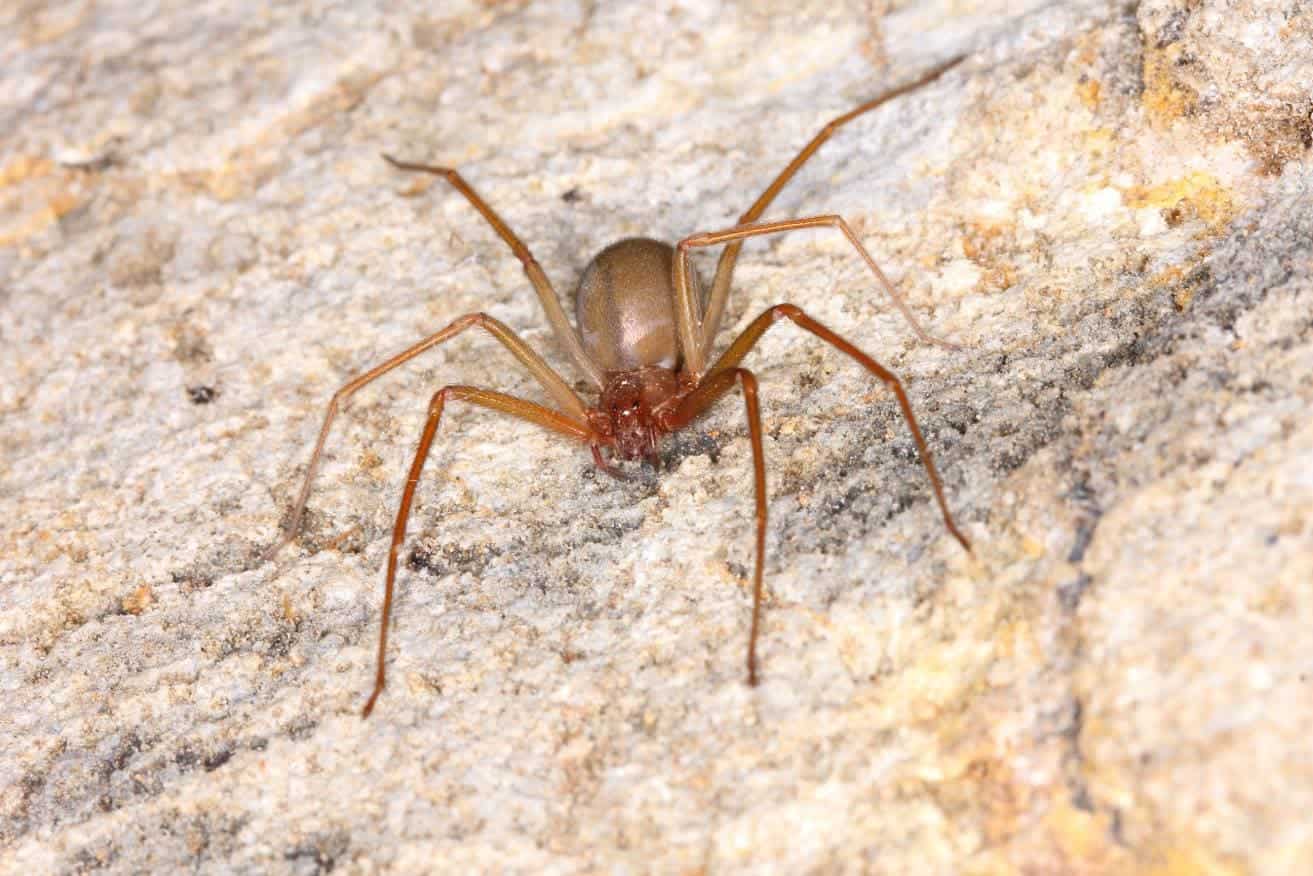Located right in the center of the United States, Kansas is perhaps best known as the setting of the classic film, The Wizard of Oz. For over 500 species of spiders, however, there really is no place like home when it comes to Kansas. Here are 25 common spiders found in Kansas, starting with the stateʻs two poisonous species.

The 25 Spiders Found in Kansas
1. Black Widow
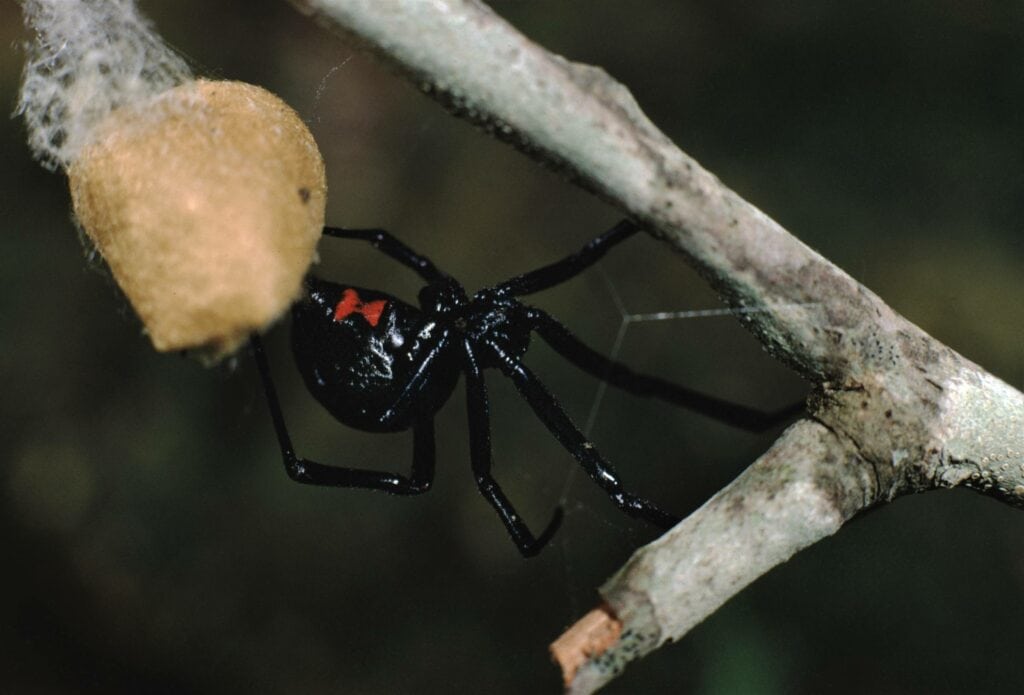
| Species: | Lactrodectus sp. |
| Longevity: | 1 – 3 years |
| Good to own as a pet?: | No |
| Legal to own?: | Yes |
| Adult size: | 0.5 inch (1.2 cm) body length |
| Diet: | Carnivorous |
Black widows are one of two types of poisonous spiders native to Kansas. Found in forests, grasslands, or the dark corners of buildings, female black widows display a distinctive red hourglass marking on their abdomens.
2. Brown Recluse
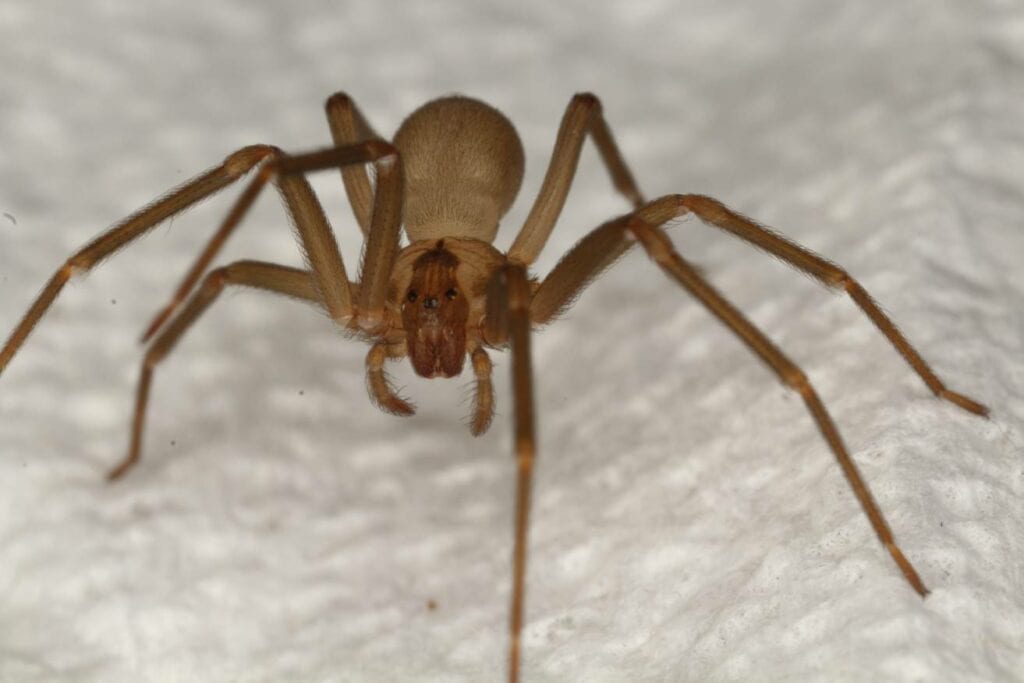
| Species: | L. reclusa |
| Longevity: | 1 – 2 years |
| Good to own as a pet?: | No |
| Legal to own?: | Yes |
| Adult size: | 0.5 inch (1.2 cm) body length |
| Diet: | Carnivorous |
The other poisonous spider found in Kansas is the Brown recluse. Also called fiddlebacks after the distinctive dark brown, violin-shaped mark on their back, these spiders are commonly found indoors, sometimes in large numbers. Larger house spiders often make a meal of the brown recluse.
3. Carolina Wolf Spider
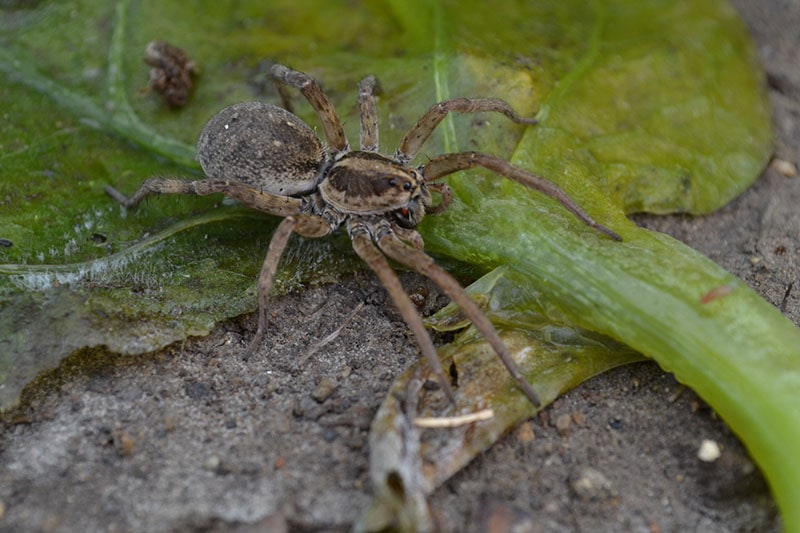
| Species: | H. carolinensis |
| Longevity: | 1 – 3 years |
| Good to own as a pet?: | Yes |
| Legal to own?: | Yes |
| Adult size: | 1.1 inch (2.8 cm) body length |
| Diet: | Carnivorous |
These large, nocturnal hunting spiders are found in prairies, yards, and sometimes houses throughout Kansas. Brown-gray in color with orange hairs on their jaws, Carolina wolf spiders eat insects and are preyed on by reptiles, birds, and small mammals.
4. Giant Fishing Spider
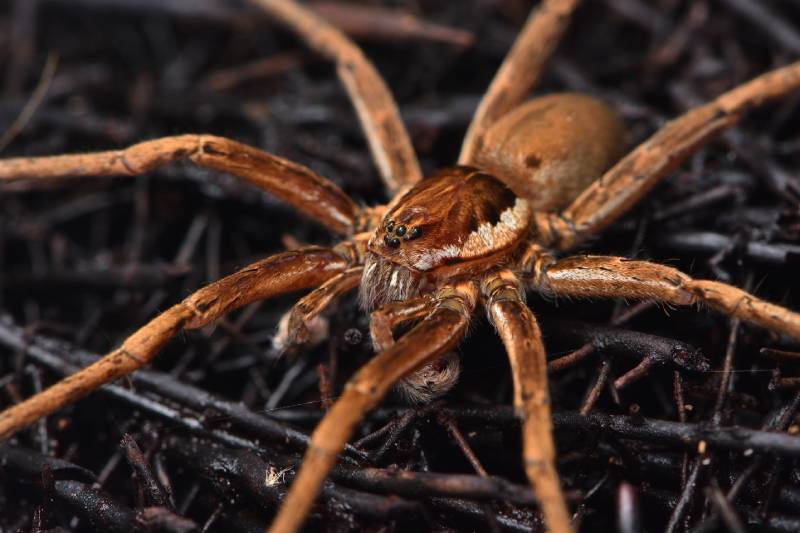
| Species: | D. tenebrosas |
| Longevity: | 1 – 2 years |
| Good to own as a pet?: | Yes |
| Legal to own?: | Yes |
| Adult size: | 1.25 inches (3.2 cm) body length |
| Diet: | Carnivorous |
Found in forests and near water sources, Giant fishing spiders are large, hairy light gray to reddish spiders. They can dive underwater and skate across the water surface hunting insects and minnows. Male giant fishing spiders die as soon as they are done mating.
5. Black and Yellow Garden Spider
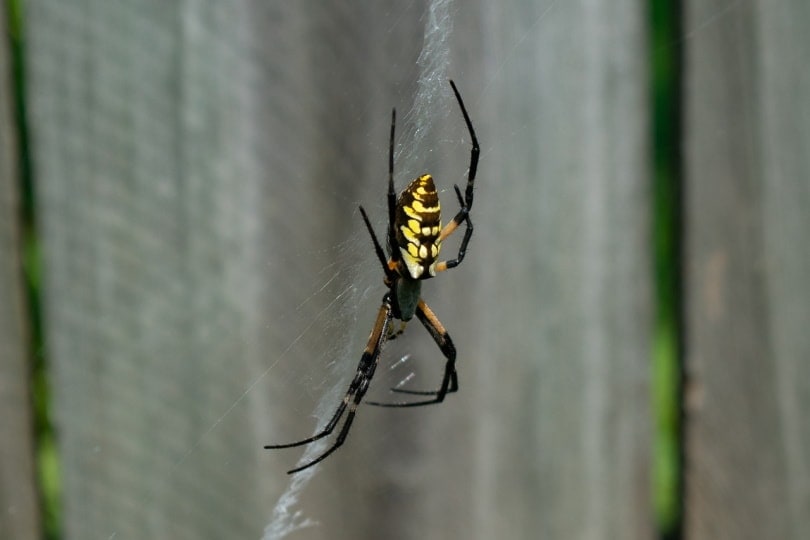
| Species: | A. aurantia |
| Longevity: | 1 year |
| Good to own as a pet?: | No |
| Legal to own?: | Yes |
| Adult size: | 1 inch (2.5 cm) body length |
| Diet: | Carnivorous |
Commonly found in bushes, yards, and fields, Black and yellow garden spiders build large round webs to snare insects and other spiders. Females lay eggs in the fall and usually donʻt survive the first frost. Birds often eat the spider hatchlings over the winter.
6. Black-footed Yellow Sac Spider
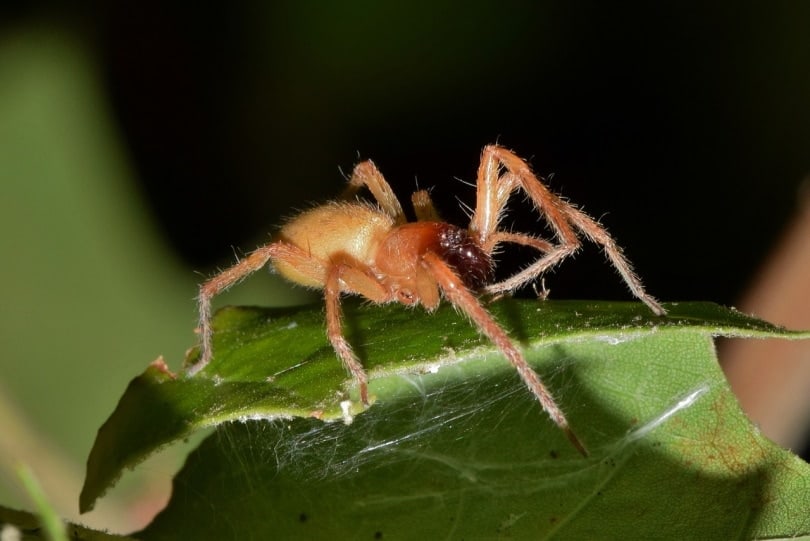
| Species: | C. inclusum |
| Longevity: | 1 – 2 years |
| Good to own as a pet?: | No |
| Legal to own?: | Yes |
| Adult size: | 0.2-.35 inch (0.5-0.9 cm) body length |
| Diet: | Carnivorous |
Also called simply the yellow sac spider, these light yellow spiders are nocturnal hunters, often found in houses. While not considered poisonous spiders, they are responsible for many spider bites because their nighttime excursions often lead them into contact with people or their clothing.
7. Common Star-bellied Orb Weaver
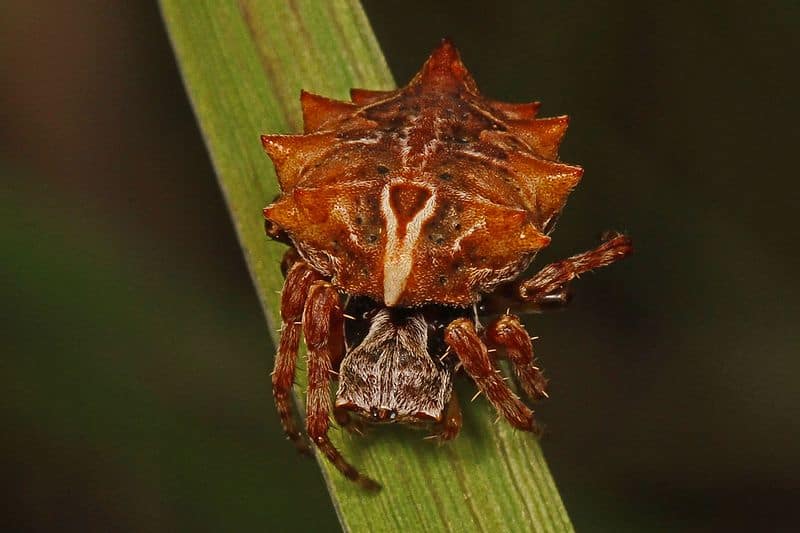
| Species: | A. stellata |
| Longevity: | 1 year |
| Good to own as a pet?: | Yes |
| Legal to own?: | Yes |
| Adult size: | 0.5 inch (1.2 cm) body length |
| Diet: | Carnivorous |
These spiders are identified by the dozen or so blunt spines found around the edge of their abdomen. Star-bellied orb-weavers build their webs in prairies and forest edges to catch insects like beetles and grasshoppers.
8. Ridge-faced Flower Spider
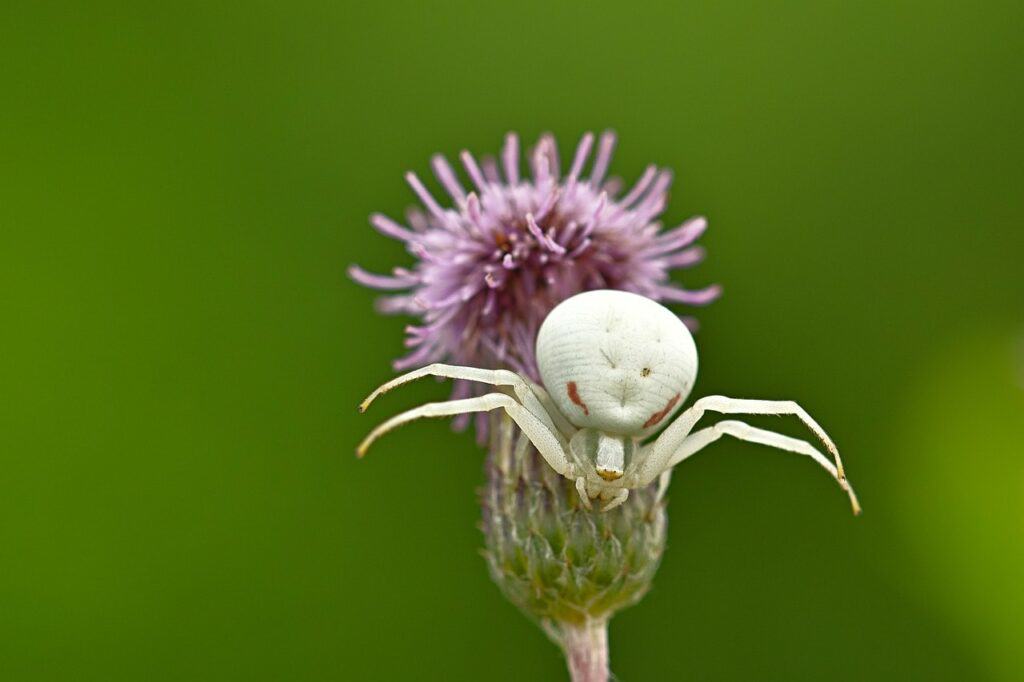
| Species: | M. formosipes |
| Longevity: | 1 year |
| Good to own as a pet?: | No |
| Legal to own?: | Yes |
| Adult size: | 0.3 inch (0.76 cm) body length |
| Diet: | Carnivorous |
Also called the white-banded crab spider, this species is green-yellow with brown markings and a raised white ridge on the face. Flower spiders are hunting spiders that will station themselves on colorful blooms to prey on the bees, butterflies, and flies who visit them.
9. Woodlouse Spider
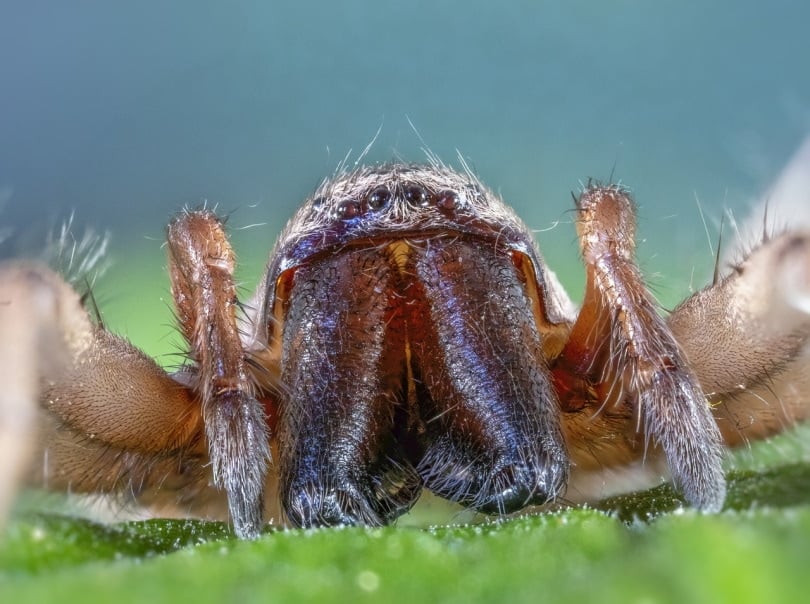
| Species: | D. crocata |
| Longevity: | 3 – 4 years |
| Good to own as a pet?: | No |
| Legal to own?: | Yes |
| Adult size: | 0.6 inch (1.5 cm) body length |
| Diet: | Carnivorous |
Red-orange in color with large jaws, the woodlouse spider preys mostly on pillbugs and millipedes. They live in damp areas around human dwellings or bridges. Other spiders and scorpions are common predators of this species.
10. Emerald Jumping Spider
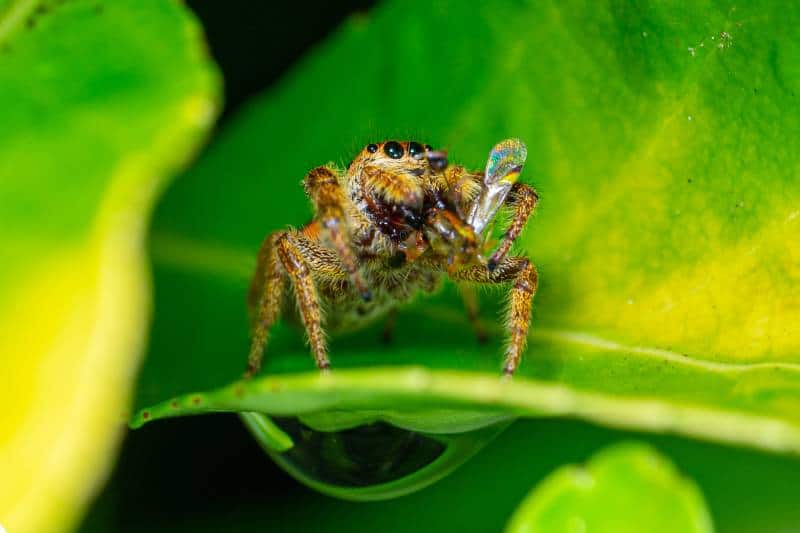
| Species: | P. aurantius |
| Longevity: | 1 year |
| Good to own as a pet?: | Yes |
| Legal to own?: | Yes |
| Adult size: | 0.4 inch (1 cm) body length |
| Diet: | Carnivorous |
Brown and black with a bright green sheen, the Emerald jumping spider is a hunting species found in woods and wetlands. They have excellent vision and powerful legs, allowing them to jump long distances and pounce on their insect prey.
11. Triangulate Orbweaver
| Species: | V. arenata |
| Longevity: | 1 year |
| Good to own as a pet?: | Yes |
| Legal to own?: | Yes |
| Adult size: | 0.3 inch (0.76 cm) body length |
| Diet: | Carnivorous |
Also called an Arrowhead spider, this species has a triangle-shaped abdomen marked by a large white or yellow triangle. They build large round webs in the woods where they help control the local mosquito and gnat population.
12. Eastern Funnelweb Spider
| Species: | A. naevia |
| Longevity: | 1 – 2 years |
| Good to own as a pet?: | Yes |
| Legal to own?: | Yes |
| Adult size: | 1 inch (2.5 cm) body length |
| Diet: | Carnivorous |
Commonly called grass spiders, this spider is one of 8 funnel-web species found in Kansas. They build 2-3 feet wide webs in long grass, complete with a funnel on one side where the spider waits to gobble up trapped insects. Other small cobweb spiders often take up residence in the giant webs of the Eastern funnel-web spider.
13. Texas Crab Spider
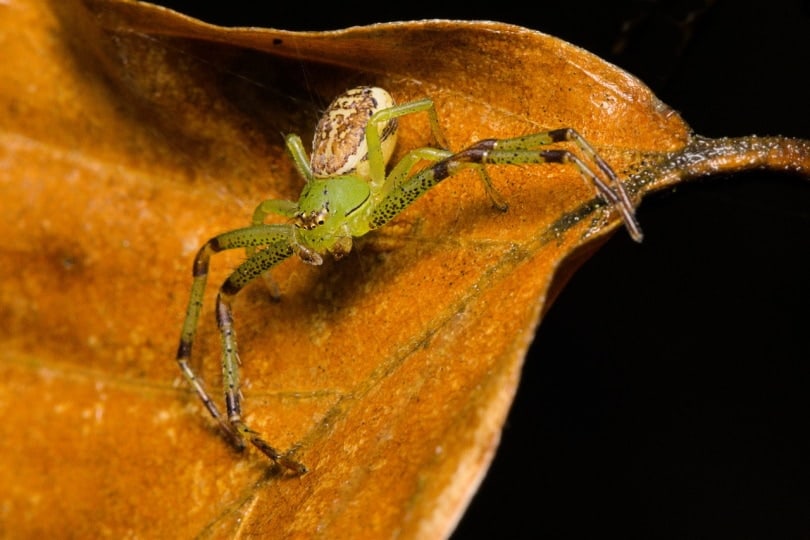
| Species: | X. texanus |
| Longevity: | 1 year |
| Good to own as a pet?: | No |
| Legal to own?: | Yes |
| Adult size: | 0.25 inch (0.6 cm) body length |
| Diet: | Carnivorous |
A small hunting spider, the Texas crab spider has pale legs with black ends and a brown abdomen with light stripes. They are found in fields and around houses, where they feed on a variety of insects. Mud dauber wasps and larger spiders are among their natural predators.
14. Eastern Parson Spider
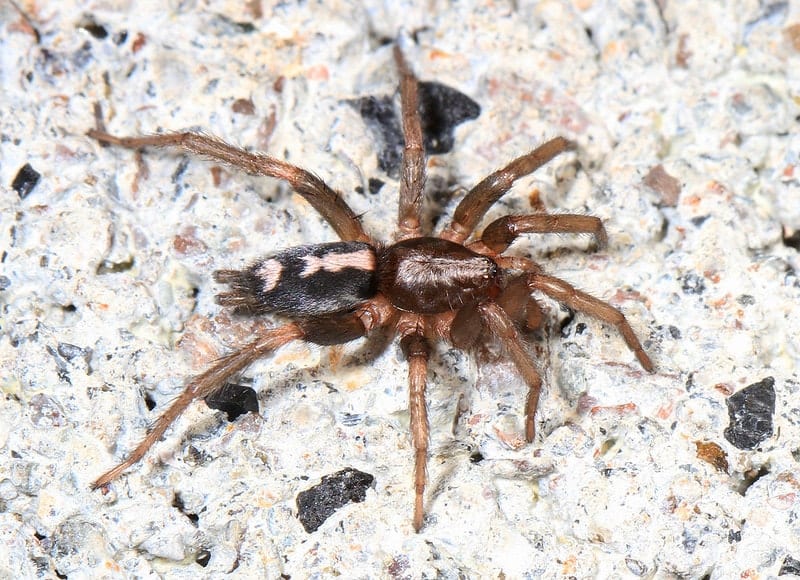
| Species: | H. ecclesiasticus |
| Longevity: | 1 – 2 years |
| Good to own as a pet?: | No |
| Legal to own?: | Yes |
| Adult size: | 0.3 inch (0.76 cm) body length |
| Diet: | Carnivorous |
Speedy little hunters, parson spiders are black or brown with a white stripe down their abdomen. Parson spiders are common both in the woods and in houses. They spin silk sacs to live in during the Kansas winter.
15. Elongated Cellar Spider
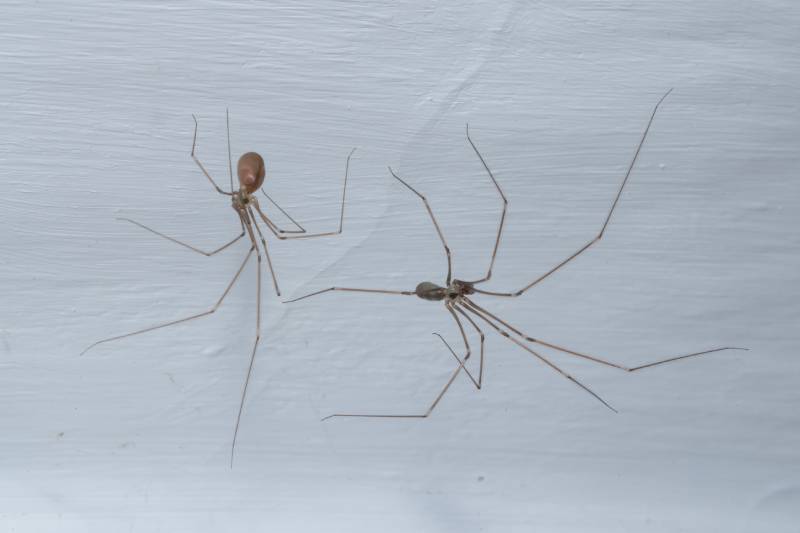
| Species: | P. phalangioides |
| Longevity: | 2 years |
| Good to own as a pet?: | No |
| Legal to own?: | Yes |
| Adult size: | 0.5 inch (1.2 cm) body length |
| Diet: | Carnivorous |
A thin pale body with brown markings and extra-long skinny legs are hallmarks of the Elongated Cellar Spider. They build webs in basement and roof corners, trapping and feeding on a variety of insects. Females carry their egg sacs in their mouths until they are ready to hatch.
16. Triangulate Cobweb Spider
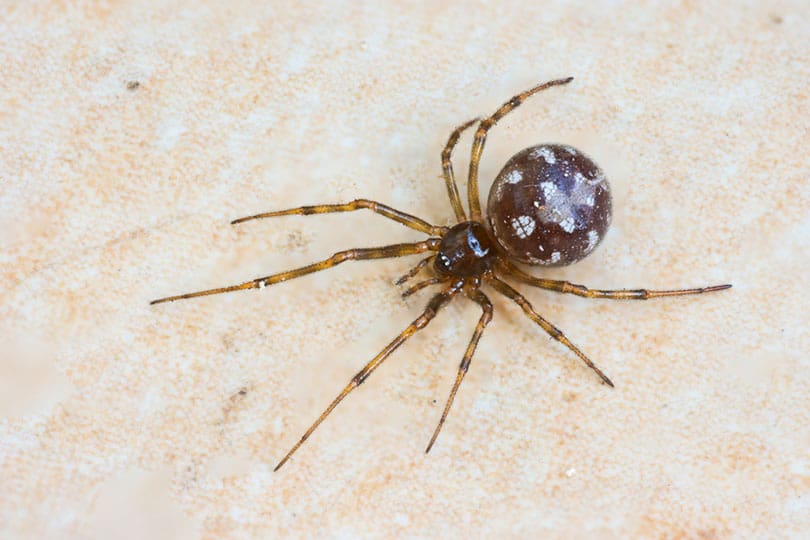
| Species: | S. triangulosa |
| Longevity: | 1 – 3 years |
| Good to own as a pet?: | No |
| Legal to own?: | Yes |
| Adult size: | 0.25 inch (0.6 cm) body length |
| Diet: | Carnivorous |
Extremely common Kansas house spiders, Triangulate cobweb spiders are maroon in color with light triangle markings on their abdomen. They are beneficial house guests due to their regular diet of ticks, ants, and other spiders.
17. Eastern Labyrinth Orbweaver
| Species: | M. labyrinthea |
| Longevity: | 1 year |
| Good to own as a pet?: | Yes |
| Legal to own?: | Yes |
| Adult size: | 0.25 inch (0.6 cm) body length |
| Diet: | Carnivorous |
These small Orbweavers can be identified by their distinctive web design. Labyrinth orb-weavers build the classic round web but also a smaller, tangled web nearby to rest and wait for prey. They are found in the woods of Kansas.
18. Texas Brown Tarantula

| Species: | A. hentzi |
| Longevity: | up to 25 years (females) |
| Good to own as a pet?: | Yes |
| Legal to own?: | Yes |
| Adult size: | 2.3 inch (5.8 cm) body length |
| Diet: | Carnivorous |
The largest spider in Kansas, these tarantulas are hairy with large jaws. They prefer to live in rocky terrain, where they create silk-lined burrows and prey on insects. When threatened, they defend themselves by throwing barbed hair from their abdomen at their attacker.
19. Puritan Pirate Spider
| Species: | M. puritanus |
| Longevity: | 1 year |
| Good to own as a pet?: | No |
| Legal to own?: | Yes |
| Adult size: | 0.3 inch (0.76 cm) body length |
| Diet: | Carnivorous |
Puritan pirate spiders are a menace to web-building spiders. They hunt by finding a web, shaking it to imitate trapped prey, and then making a meal out of the unsuspecting web builder who pops out to investigate.
20. Striped Lynx Spider

| Species: | O. salticus |
| Longevity: | 1 year |
| Good to own as a pet?: | No |
| Legal to own?: | Yes |
| Adult size: | 0.25 inch (0.6 cm) body length |
| Diet: | Carnivorous |
Striped lynx spiders are identified by their unusual spiny legs and two dark stripes on their light faces. These spiders are speedy hunters, feeding on insects and other spiders in grassy habitats. Jumping spiders are a common predator.
21. Common Nursery Web Spider
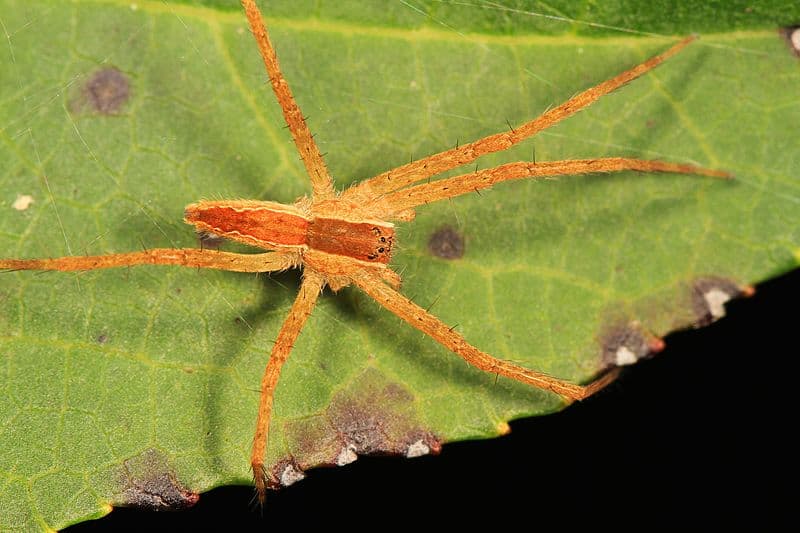
| Species: | P. mira |
| Longevity: | 1 – 2 years |
| Good to own as a pet?: | Yes |
| Legal to own?: | Yes |
| Adult size: | 0.75 inch (1.9 cm) body length |
| Diet: | Carnivorous |
Nursery web spiders are named for the protective web the females build to surround their babies as they hatch and develop. They are hunting spiders found in wooded areas. The males court the females by offering a gift of prey, wrapped in silk.
22. Western Lance Spider
| Species: | S. mccooki |
| Longevity: | 1 – 2 years |
| Good to own as a pet?: | No |
| Legal to own?: | Yes |
| Adult size: | 0.5 inch (1.2 cm) body length |
| Diet: | Carnivorous |
Western lance spiders are named for the brown lance-shaped mark on their bodies. They are common in grassy habitats and often live in prairie dog towns.
23. Common Zebra Spider
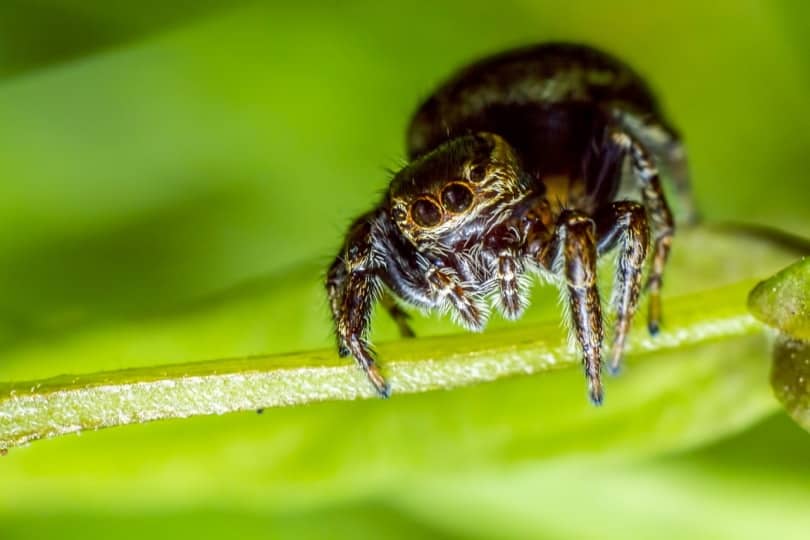
| Species: | S. scenicas |
| Longevity: | 2 – 3 years |
| Good to own as a pet?: | Yes |
| Legal to own?: | Yes |
| Adult size: | 0.25 inch (0.6 cm) body length |
| Diet: | Carnivorous |
Zebra spiders are brown with two white triangles behind their eyes and three thick white stripes on their abdomen. They have good vision which they use to hunt small flying insects. Zebra spiders prefer sunny, vertical locations such as tree trunks, fences, and walls.
24. Bowl and Doily Spider
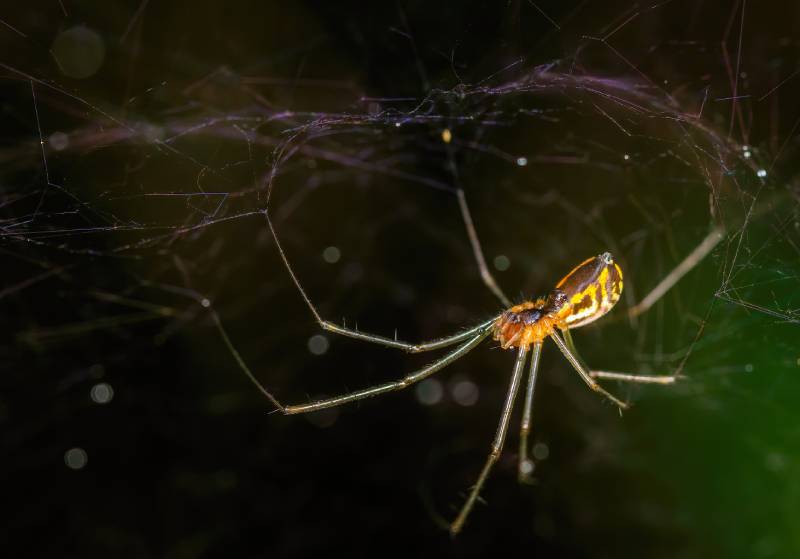
| Species: | F. communis |
| Longevity: | 1 year |
| Good to own as a pet?: | No |
| Legal to own?: | Yes |
| Adult size: | 0.17 inch (0.43 cm) body length |
| Diet: | Carnivorous |
These small brown and white striped spiders are most easily identified by their webs. They create a large bowl-shaped web with a second flat web underneath. The flat web protects the bowl and doily spider from beneath as they wait to eat small insects caught in their bowl.
25. Filmy Dome Spider

| Species: | N. radiata |
| Longevity: | 1 year |
| Good to own as a pet?: | No |
| Legal to own?: | Yes |
| Adult size: | 0.17 inch (0.43 cm) body length |
| Diet: | Carnivorous |
A common inhabitant of wooded areas, these small spiders build dome-shaped webs to catch mainly small flies and leafhoppers. Males and females often live together on the same web, unusual among spider species. Larger spiders often prey on the filmy dome spider.

Conclusion
While spiders are often unfairly feared, Kansas only has two poisonous spider species and their bite, while painful, is rarely fatal. All 25 spiders listed, including the black widow and brown recluse, are beneficial to their human neighbors, consuming enormous quantities of pests like flies and mosquitoes. These spiders are right at home in Kansas and they didnʻt even have to click their heels to get there!
Related read:
Featured Image Credit by Pong Wira, Shutterstock
